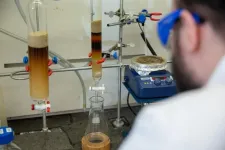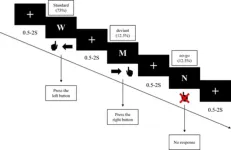(Press-News.org) The shape and size of a grain of rice, the new device can conduct dozens of experiments at once to study the effects of new treatments on some of the hardest-to-treat brain cancers.
Researchers from Brigham and Women’s Hospital, a founding member of the Mass General Brigham healthcare system, have designed a device that can help test treatments in patients with gliomas, a type of tumor that originates in the brain or spinal cord. The device, which is designed to be used during standard of care surgery, provides unprecedented insight into the effects of drugs on glioma tumors and caused no adverse effects on patients in a phase 1 clinical trial. Results from the pilot clinical trial for the device are published in Science Translational Medicine.
“In order to make the greatest impact on how we treat these tumors, we need to be able to understand, early on, which drug works best for any given patient,” said co-principal investigator and co-corresponding author Pierpaolo Peruzzi, MD, PhD, an assistant professor in the Department of Neurosurgery at Brigham and Women’s Hospital. “The problem is that the tools that are currently available to answer this question are just not good enough. So we came up with the idea of making each patient their own lab, by using a device which can directly interrogate the living tumor and give us the information that we need.”
About 20,000 people in the U.S. each year are diagnosed with gliomas, a type of tumor that affects the brain and spinal cord. Gliomas are also among the deadliest brain cancers and are notoriously difficult to treat.
One challenge in developing targeted therapies for glioma is that it can be difficult to test many different combinations of drugs in tumor cells, because it’s only possible to treat patients with one approach at a time. This has been a significant barrier for hard-to-treat cancers like gliomas, for which combination therapies are a promising avenue.
Peruzzi worked closely with co-principal investigator Oliver Jonas, PhD, an associate professor in the department of Radiology at the Brigham, to develop a device that can work around some of the barriers to precision medicine in gliomas. These microdevices are implanted in a patient’s tumor during surgery and removed before the surgery is complete.
“It’s important that we are able to do this in a way that best captures the features of each patient’s tumor and, at the same time, is the least disruptive of the standard of care,” said Peruzzi. “This makes our approach easy to integrate into patients’ treatment and allows its use in real life.”
In the time the device is implanted—about 2-3 hours—it administers tiny doses of up to 20 drugs into extremely small areas of the patient’s brain tumor. The device is removed during the surgery and the surrounding tissue is returned to the lab for analysis.
Because the device works while the tumor is still in the body, conducting experiments this way gives unparalleled ability to assess the effects of drugs on the tumor microenvironment, the cells immediately surrounding cancer cells that can make up almost half the mass of a tumor.
“This is not in the lab, and not in a petri dish,” said Peruzzi. “It's actually in real patients in real time, which gives us a whole new perspective on how these tumors respond to treatment.”
In the current study, the researchers tested their device on six patients undergoing brain surgery to remove a glioma tumor. None of the patients experienced any adverse effects from the device, and the researchers were able to collect valuable biological data from the devices, such as how the response changes based on drug concentrations, or what molecular changes each drug produces in the cells.
While the study demonstrated that the device was safe and could be easily incorporated into surgical practice, the researchers are still working on determining the exact ways the data it gathers should be used to optimize glioma therapy. The researchers are currently conducting a two-stage version of their procedure in which patients receive the device through minimally invasive surgery 72 hours before their main surgery.
“We’re optimistic that this is a new generation approach for personalized medicine,” said Peruzzi. “The ability to bring the lab right to the patient unlocks so much potential in terms of the type of information we can gather, which is new and exciting territory for a disease that has very few options at present.”
Disclosures: Pierpaolo Peruzzi is co-founder and on Board of Directors of Ternalys Therapeutics. He is a named inventor on microRNA-related patent PCT/US2019/029988. Jonas is a coinventor of the IMD technology (U.S. patent no. US10390702B2) and is a consultant with compensation (non-equity) to Kibur Medical. Co-author Antonio Chiocca is a named inventor on patents related to oncolytic HSV1 (U.S. patent nos. US10,806,761B2 US10,232,002B1, and US2017/0015757A1) and noncoding RNAs (PCT/US2019/029988).
Funding: This study was supported by grants from the National Institutes of Health (R37CA224144, P41EB028741) and the National Institute of Neurological Disorders and Stroke (1R01NS116144).
Paper cited: Peruzzi, P. et al. “Intratumoral drug-releasing microdevices allow in situ high throughput pharmaco phenotyping in patients with gliomas” Science Translational Medicine. DOI: 10.1126/scitranslmed.adf6598
###
END
ITHACA, N.Y. - As the Earth’s human population grows, greenhouse gas emissions from the world’s food system are on track to expand. A new study demonstrates that state-of-the-art agricultural technology and management can not only reduce that growth, but eliminate it altogether by generating net negative emissions – reducing more greenhouse gas than food systems add.
In fact, employing additional agricultural technology could result in more than 13 billion tons of net negative greenhouse gas emissions each year, as the world seeks to avoid dangerous climate extremes, according to research published Sept. 6 in PLOS Climate.
The work was led by Benjamin ...
Remembering the order of information is central for a person when participating in conversations, planning everyday life, or undergoing an education. A new study, published in the scientific journal PLoS One, shows that this ability is probably human unique. Even the closest relatives of humans, such as bonobos, do not learn order in the same way.
“The study contributes another piece of the puzzle to the question of how the mental abilities of humans and other animals differ, and why only humans speak languages, plan space travel, and have learned to exploit the earth so efficiently that we now pose a serious ...
Footballers wearing jerseys featuring small numbers are rated as more slender than those wearing big numbers, in experiments indicating how visual perception may be influenced by cognition
###
Article URL: https://journals.plos.org/plosone/article?id=10.1371/journal.pone.0287474
Article Title: Big number, big body: Jersey numbers alter body size perception
Author Countries: USA
Funding: The authors received no specific funding for this work. END ...
Jimmy Jiang envisions a future where every house is powered by renewable energy stored in batteries.
In his chemistry lab, Jiang and his students at the University of Cincinnati have created a new battery that could have profound implications for the large-scale energy storage needed by wind and solar farms.
Innovations such as UC’s will have profound effects on green energy, Jiang said. Batteries store renewable energy for when it’s needed, not just when it’s produced. This is crucial for getting the most out of wind and solar power, he said.
“Energy ...
UNIVERSITY PARK, Pa. — This summer, viral misinformation claimed that the Amish did not vaccinate against COVID-19 and, as a result, had a death rate 90 times lower than the rest of the United States. Now, a Penn State study is the first to provide geographically broad and population-wide evidence that while the Amish-populated counties across the nation tend to have lower vaccination rates than other populations, they are not entirely unvaccinated.
The research was published recently in the journal Population Research and Policy Review.
The Amish are a distinctive Christian subculture that traces its roots to the 16th century Protestant ...
A recent article published in Volume 3 of the journal Psychoradiology, researchers from Sichuan Normal University introduced an innovative Three-Choice BIC paradigm that merges the GNG and two-choice oddball (TCO) tasks. This study engaged 48 college students who responded to varied stimuli using designated keys and restrained responses to no-go stimuli. Employing functional neuroimaging coupled with conjunction and ROI analyses, the researchers sought to unveil unique neural pathways linked to BIC ...
ROCHESTER, Minn. — The treadmill exercise test with electrocardiogram (ECG), also known as an exercise stress test, is one of the most familiar tests in medicine. While exercise testing typically is focused on diagnosing coronary artery disease, a recent study from Mayo Clinic finds that exercise test abnormalities, such as low functional aerobic capacity, predicted non-cardiovascular causes of death such as cancer in addition to cardiovascular-related deaths. These new findings are published in Mayo Clinic Proceedings.
The exercise stress test is noninvasive, easily available and provides important diagnostic information. In addition to the ECG itself, ...
DENVER/Sept. 6, 2023 — A newly funded study will evaluate both the frequency and major risk factors for cancer in golden retrievers, a breed commonly affected by the disease.
The study will use data from Morris Animal Foundation’s Golden Retriever Lifetime Study, which is one of the largest and most comprehensive canine health studies in the world. The study will also incorporate data from Veterinary Companion Animal Surveillance System (VetCompass), a not-for-profit research project based at the Royal Veterinary College ...
LA JOLLA, CA—A good night’s sleep has many proven health benefits, and a new Scripps Research study suggests one more: preventing opioid relapse.
In the new study, published online in Neuropharmacology on August 12, 2023, scientists gave an experimental insomnia treatment to rats experiencing oxycodone withdrawal. The researchers found that the animals were far less likely to seek out drugs again in the future—even after ending the treatment. These findings could eventually lead to therapies to help prevent opioid addiction or relapse in humans.
“These results are very encouraging,” says Rémi Martin-Fardon, PhD, associate professor of molecular medicine ...
The researchers studied birds given a simulated bacterial infection in order to stimulate their immune system. The birds were then compared with birds whose immune system was not stimulated – and their activity was measured for several weeks using miniature data loggers.
“We found that the birds whose immune system was stimulated had reduced activity for three weeks, which is much longer than we expected. We could also see that the "sick" blackbirds stopped their activities ...



